Vincent Lauinger
Novel Phase-Noise-Tolerant Variational-Autoencoder-Based Equalization Suitable for Space-Division-Multiplexed Transmission
Sep 17, 2025Abstract:We demonstrate the effectiveness of a novel phase-noise-tolerant, variational-autoencoder-based equalization scheme for space-division-multiplexed (SDM) transmission in an experiment over 150km of randomly-coupled multi-core fibers.
Recent Advances on Machine Learning-aided DSP for Short-reach and Long-haul Optical Communications
Nov 15, 2024


Abstract:In this paper, we highlight recent advances in the use of machine learning for implementing equalizers for optical communications. We highlight both algorithmic advances as well as implementation aspects using conventional and neuromorphic hardware.
CNN-Based Equalization for Communications: Achieving Gigabit Throughput with a Flexible FPGA Hardware Architecture
Apr 22, 2024

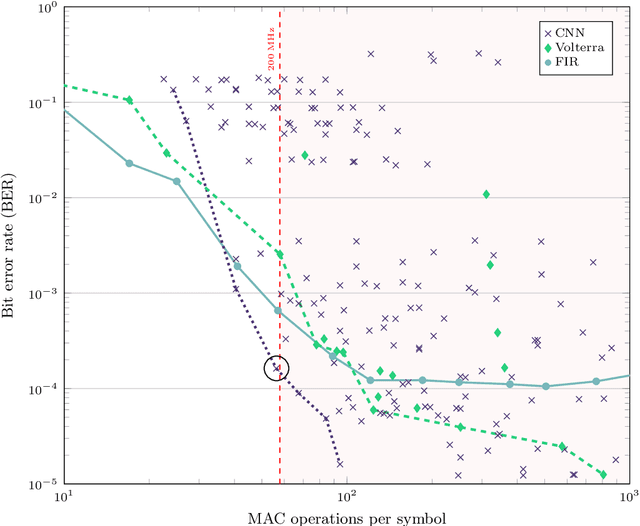
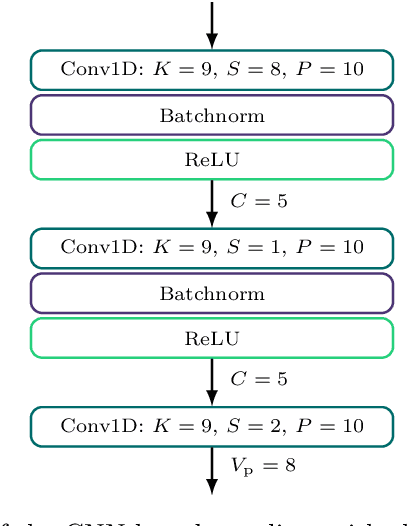
Abstract:To satisfy the growing throughput demand of data-intensive applications, the performance of optical communication systems increased dramatically in recent years. With higher throughput, more advanced equalizers are crucial, to compensate for impairments caused by inter-symbol interference (ISI). The latest research shows that artificial neural network (ANN)-based equalizers are promising candidates to replace traditional algorithms for high-throughput communications. On the other hand, not only throughput but also flexibility is a main objective of beyond-5G and 6G communication systems. A platform that is able to satisfy the strict throughput and flexibility requirements of modern communication systems are field programmable gate arrays (FPGAs). Thus, in this work, we present a high-performance FPGA implementation of an ANN-based equalizer, which meets the throughput requirements of modern optical communication systems. Further, our architecture is highly flexible since it includes a variable degree of parallelism (DOP) and therefore can also be applied to low-cost or low-power applications which is demonstrated for a magnetic recording channel. The implementation is based on a cross-layer design approach featuring optimizations from the algorithm down to the hardware architecture, including a detailed quantization analysis. Moreover, we present a framework to reduce the latency of the ANN-based equalizer under given throughput constraints. As a result, the bit error ratio (BER) of our equalizer for the optical fiber channel is around four times lower than that of a conventional one, while the corresponding FPGA implementation achieves a throughput of more than 40 GBd, outperforming a high-performance graphics processing unit (GPU) by three orders of magnitude for a similar batch size.
Real-Time FPGA Demonstrator of ANN-Based Equalization for Optical Communications
Feb 23, 2024

Abstract:In this work, we present a high-throughput field programmable gate array (FPGA) demonstrator of an artificial neural network (ANN)-based equalizer. The equalization is performed and illustrated in real-time for a 30 GBd, two-level pulse amplitude modulation (PAM2) optical communication system.
Fully-blind Neural Network Based Equalization for Severe Nonlinear Distortions in 112 Gbit/s Passive Optical Networks
Jan 17, 2024



Abstract:We demonstrate and evaluate a fully-blind digital signal processing (DSP) chain for 100G passive optical networks (PONs), and analyze different equalizer topologies based on neural networks with low hardware complexity.
Blind Frequency-Domain Equalization Using Vector-Quantized Variational Autoencoders
Dec 26, 2023


Abstract:We propose a novel frequency-domain blind equalization scheme for coherent optical communications. The method is shown to achieve similar performance to its recently proposed time-domain counterpart with lower computational complexity, while outperforming the commonly used CMA-based equalizers.
Unsupervised ANN-Based Equalizer and Its Trainable FPGA Implementation
Apr 14, 2023



Abstract:In recent years, communication engineers put strong emphasis on artificial neural network (ANN)-based algorithms with the aim of increasing the flexibility and autonomy of the system and its components. In this context, unsupervised training is of special interest as it enables adaptation without the overhead of transmitting pilot symbols. In this work, we present a novel ANN-based, unsupervised equalizer and its trainable field programmable gate array (FPGA) implementation. We demonstrate that our custom loss function allows the ANN to adapt for varying channel conditions, approaching the performance of a supervised baseline. Furthermore, as a first step towards a practical communication system, we design an efficient FPGA implementation of our proposed algorithm, which achieves a throughput in the order of Gbit/s, outperforming a high-performance GPU by a large margin.
Blind Channel Equalization Using Vector-Quantized Variational Autoencoders
Feb 22, 2023
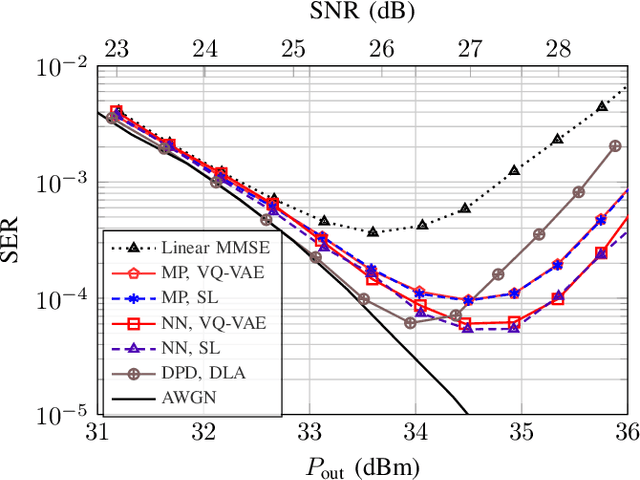


Abstract:State-of-the-art high-spectral-efficiency communication systems employ high-order modulation formats coupled with high symbol rates to accommodate the ever-growing demand for data rate-hungry applications. However, such systems are more vulnerable to linear and nonlinear transmission impairments, and it is important to mitigate the performance loss via digital signal processing. In this paper, we propose a novel machine learning approach for blind channel equalization and estimation using the vector quantized (VQ) \ac{VAE} framework. The proposed approach generalizes the applicability of the conventional \ac{VAE}-based equalizer to nonlinear systems employing high-order modulation formats by introducing a codebook component and an associated novel loss function. We evaluate the performance of the proposed method over a linear additive white Gaussian noise channel with intersymbol interference and two nonlinear scenarios. Simulation results show that the proposed method can achieve similar performance as a data aided equalizer using the \acf{MMSE} criterion, and outperforms the blind\ac{CMA} and the \ac{VAE}-based channel equalizer. Furthermore, we show that for the linear channel, the proposed scheme exhibits better convergence properties than the \ac{MMSE}-based, the \ac{CMA}-based, and the \ac{VAE}-based equalizers in terms of both convergence speed and robustness to variations in training batch size and learning rate.
Improving the Bootstrap of Blind Equalizers with Variational Autoencoders
Jan 16, 2023


Abstract:We evaluate the start-up of blind equalizers at critical working points, analyze the advantages and obstacles of commonly-used algorithms, and demonstrate how the recently-proposed variational autoencoder (VAE) based equalizers can improve bootstrapping.
Blind and Channel-agnostic Equalization Using Adversarial Networks
Sep 15, 2022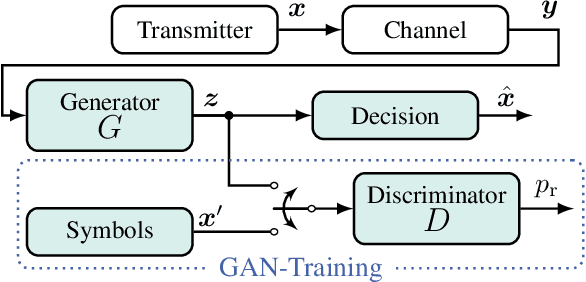
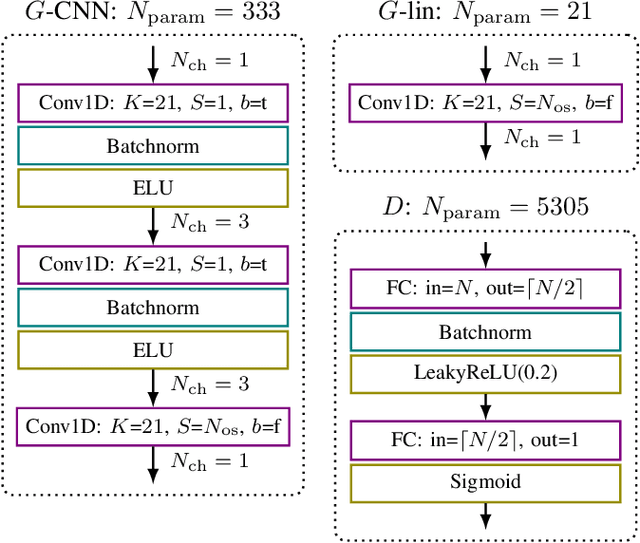


Abstract:Due to the rapid development of autonomous driving, the Internet of Things and streaming services, modern communication systems have to cope with varying channel conditions and a steadily rising number of users and devices. This, and the still rising bandwidth demands, can only be met by intelligent network automation, which requires highly flexible and blind transceiver algorithms. To tackle those challenges, we propose a novel adaptive equalization scheme, which exploits the prosperous advances in deep learning by training an equalizer with an adversarial network. The learning is only based on the statistics of the transmit signal, so it is blind regarding the actual transmit symbols and agnostic to the channel model. The proposed approach is independent of the equalizer topology and enables the application of powerful neural network based equalizers. In this work, we prove this concept in simulations of different -- both linear and nonlinear -- transmission channels and demonstrate the capability of the proposed blind learning scheme to approach the performance of non-blind equalizers. Furthermore, we provide a theoretical perspective and highlight the challenges of the approach.
 Add to Chrome
Add to Chrome Add to Firefox
Add to Firefox Add to Edge
Add to Edge